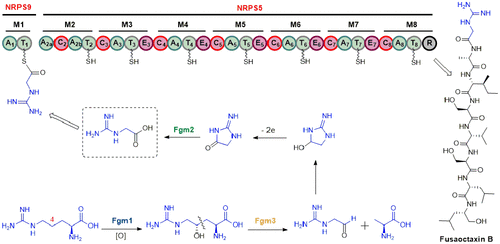当前位置:
X-MOL 学术
›
J. Am. Chem. Soc.
›
论文详情
Our official English website, www.x-mol.net, welcomes your feedback! (Note: you will need to create a separate account there.)
Biosynthesis of a New Fusaoctaxin Virulence Factor in Fusarium graminearum Relies on a Distinct Path To Form a Guanidinoacetyl Starter Unit Priming Nonribosomal Octapeptidyl Assembly
Journal of the American Chemical Society ( IF 15.0 ) Pub Date : 2021-11-16 , DOI: 10.1021/jacs.1c07770 Zhijun Tang 1 , Haoyu Tang 1 , Wanqiu Wang 2 , Yufeng Xue 1 , Dandan Chen 1 , Weihua Tang 2 , Wen Liu 1, 3
Journal of the American Chemical Society ( IF 15.0 ) Pub Date : 2021-11-16 , DOI: 10.1021/jacs.1c07770 Zhijun Tang 1 , Haoyu Tang 1 , Wanqiu Wang 2 , Yufeng Xue 1 , Dandan Chen 1 , Weihua Tang 2 , Wen Liu 1, 3
Affiliation

|
Fusarium graminearum is a pathogenic fungus causing huge economic losses worldwide via crop infection leading to yield reduction and grain contamination. The process through which the fungal invasion occurs remains poorly understood. We recently characterized fusaoctaxin A in F. graminearum, where this octapeptide virulence factor results from an assembly line encoded in fg3_54, a gene cluster proved to be involved in fungal pathogenicity and host adaptation. Focusing on genes in this cluster that are related to fungal invasiveness but not to the biosynthesis of fusaoctaxin A, we here report the identification and characterization of fusaoctaxin B, a new octapeptide virulence factor with comparable activity in wheat infection. Fusaoctaxin B differs from fusaoctaxin A at the N-terminus by possessing a guanidinoacetic acid (GAA) unit, formation of which depends on the combined activities of the protein products of fgm1–3. Fgm1 is a cytochrome P450 protein that oxygenates l-Arg to 4(R)-hydroxyl-l-Arg in a regio- and stereoselective manner. Then, Cβ–Cγ bond cleavage proceeds in the presence of Fgm3, a pyridoxal-5′-phosphate-dependent lyase, giving guanidinoacetaldehyde and l-Ala. Rather than being directly oxidized to GAA, the guanidine-containing aldehyde undergoes spontaneous cyclization and subsequent enzymatic dehydrogenation to provide glycociamidine, which is linearized by Fgm2, a metallo-dependent amidohydrolase. The GAA path in F. graminearum is distinct from that previously known to involve l-Arg:l-Gly aminidotransferase activity. To provide this nonproteinogenic starter unit that primes nonribosomal octapeptidyl assembly, F. graminearum employs new chemistry to process l-Arg through inert C–H bond activation, selective C–C bond cleavage, cyclization-based alcohol dehydrogenation, and amidohydrolysis-associated linearization.
中文翻译:

禾谷镰刀菌中新的 Fusaoctaxin 毒力因子的生物合成依赖于形成胍基乙酰基起始单元引发非核糖体八肽基组装的不同途径
禾谷镰刀菌是一种病原真菌,通过作物感染导致减产和谷物污染,在全球范围内造成巨大的经济损失。真菌入侵发生的过程仍然知之甚少。我们最近对禾谷镰刀菌中的 fusaoctaxin A 进行了表征,其中这种八肽毒力因子是由fg3_54中编码的装配线产生的。,一个基因簇被证明与真菌致病性和宿主适应有关。专注于该簇中与真菌侵袭性相关但与 fusaoctaxin A 的生物合成无关的基因,我们在此报告了 fusaoctaxin B 的鉴定和表征,这是一种在小麦感染中具有相当活性的新八肽毒力因子。Fusaoctaxin B 在 N 末端与 fusaoctaxin A 不同,它具有一个胍基乙酸 (GAA) 单元,其形成取决于fgm1-3蛋白质产物的组合活性。Fgm1 是一种细胞色素 P450 蛋白,它以区域选择性和立体选择性的方式将l- Arg 氧化为 4( R )-羟基-l- Arg。那么,C β -C γ在 Fgm3(一种 pyridoxal-5'-phosphate 依赖性裂解酶)存在下进行键断裂,产生胍基乙醛和l -Ala 。含胍的醛不是直接氧化成 GAA,而是进行自发环化和随后的酶促脱氢以提供糖环脒,其由金属依赖性酰胺水解酶 Fgm2 线性化。F. graminearum中的 GAA 路径与之前已知的涉及l -Arg :l- Gly 氨基转移酶活性的路径不同。为了提供这种能引发非核糖体八肽基组装的非蛋白质起始单元,禾谷镰刀菌采用新的化学方法来处理l-Arg 通过惰性 C-H 键活化、选择性 C-C 键裂解、基于环化的醇脱氢和酰胺水解相关的线性化。
更新日期:2021-12-01
中文翻译:

禾谷镰刀菌中新的 Fusaoctaxin 毒力因子的生物合成依赖于形成胍基乙酰基起始单元引发非核糖体八肽基组装的不同途径
禾谷镰刀菌是一种病原真菌,通过作物感染导致减产和谷物污染,在全球范围内造成巨大的经济损失。真菌入侵发生的过程仍然知之甚少。我们最近对禾谷镰刀菌中的 fusaoctaxin A 进行了表征,其中这种八肽毒力因子是由fg3_54中编码的装配线产生的。,一个基因簇被证明与真菌致病性和宿主适应有关。专注于该簇中与真菌侵袭性相关但与 fusaoctaxin A 的生物合成无关的基因,我们在此报告了 fusaoctaxin B 的鉴定和表征,这是一种在小麦感染中具有相当活性的新八肽毒力因子。Fusaoctaxin B 在 N 末端与 fusaoctaxin A 不同,它具有一个胍基乙酸 (GAA) 单元,其形成取决于fgm1-3蛋白质产物的组合活性。Fgm1 是一种细胞色素 P450 蛋白,它以区域选择性和立体选择性的方式将l- Arg 氧化为 4( R )-羟基-l- Arg。那么,C β -C γ在 Fgm3(一种 pyridoxal-5'-phosphate 依赖性裂解酶)存在下进行键断裂,产生胍基乙醛和l -Ala 。含胍的醛不是直接氧化成 GAA,而是进行自发环化和随后的酶促脱氢以提供糖环脒,其由金属依赖性酰胺水解酶 Fgm2 线性化。F. graminearum中的 GAA 路径与之前已知的涉及l -Arg :l- Gly 氨基转移酶活性的路径不同。为了提供这种能引发非核糖体八肽基组装的非蛋白质起始单元,禾谷镰刀菌采用新的化学方法来处理l-Arg 通过惰性 C-H 键活化、选择性 C-C 键裂解、基于环化的醇脱氢和酰胺水解相关的线性化。



























 京公网安备 11010802027423号
京公网安备 11010802027423号